Reducing Wave Overtopping on Rubble Mound Breakwaters Using Floating Kelp Farms
Abstract
1. Introduction
2. Methodology
2.1. Experimental Set-Up
2.2. Testing Plan
- Case 0—Control tests without the presence of the floating kelp farm model;
- Case 1—Tests with a floating kelp farm model with 25 longlines;
- Case 2—Tests with a floating kelp farm model with 50 longlines;
- Case 3—Tests with a floating kelp farm model with 100 longlines.
2.3. Similarity Analysis
2.4. Wave Overtopping Signal Processing
2.5. Scaling and Model Effects
2.6. Mean Wave Overtopping Discharge, Reduction Rate, and Influence Factor
3. Experimental Results
4. Case Study: Port of Leixões
4.1. Brief Introduction to Port of Leixões
4.2. Wave Climate and Sea Level Rise Projections near Port of Leixões
4.3. Potential Wave Overtopping Reduction Promoted by a Floating Kelp Farm with Sea Level Rise
5. Conclusions
- Floating kelp farms are shown to be effective in reducing wave overtopping, which can enhance the performance and operational time window of existing coastal defence structures. Experimental tests with 25 longlines seawards of a rubble mound breakwater revealed an average wave overtopping reduction of 47%. With 50 longlines, an average wave overtopping reduction of 70% was achieved, and with 100 longlines, the average wave overtopping reduction was over 90%.
- The EurOtop manual’s wave overtopping prediction equation for rubble mound breakwaters was slightly adjusted for cases where a floating kelp farm is present seawards of the breakwater. This modification introduces a kelp factor , which accounts for the presence of the kelp farm [see Equation (6)]. can be estimated by Equation (7), and it is a function of the ratio between the farm’s cross-shore length and incident wavelength.
- The analysis, based on a hypothetical installation at the Port of Leixões, explored the impact of fully developed kelp farms (25, 50, and 100 longlines with 50, 100, and 200 m cross-shore, respectively) on wave overtopping under storm scenarios with 2- and 5-year return periods. The results point out that a kelp farm with 25 longlines can sustain wave overtopping levels below current rates until 2070, and a configuration with 50 or 100 longlines can sustain wave overtopping levels below the current values at least until 2100.
Author Contributions
Funding
Data Availability Statement
Acknowledgments
Conflicts of Interest
Appendix A
| (m) | λ (m) | /h | ak | kh | ||||||
|---|---|---|---|---|---|---|---|---|---|---|
| ID1_0 | 0.34 | 0.106 | 0 | 1.66 | 2.97 | 0.312 | 0.112 | 0.716 | 1.132 | 4.74 × 10−5 |
| ID2_0 | 0.114 | 1.66 | 2.97 | 0.335 | 0.121 | 0.716 | 1.053 | 8.09 × 10−5 | ||
| ID3_0 | 0.121 | 1.66 | 2.97 | 0.356 | 0.128 | 0.716 | 0.992 | 9.25 × 10−5 | ||
| ID4_0 | 0.115 | 2.17 | 3.90 | 0.338 | 0.093 | 0.545 | 1.043 | 1.25 × 10−4 | ||
| ID5_0 | 0.116 | 2.44 | 4.51 | 0.341 | 0.081 | 0.472 | 1.034 | 1.21 × 10−4 | ||
| ID1_1 | 0.109 | 1.25 | 1.66 | 2.97 | 0.321 | 0.115 | 0.716 | 1.101 | 1.87 × 10−5 | |
| ID2_1 | 0.116 | 1.66 | 2.97 | 0.341 | 0.123 | 0.716 | 1.034 | 2.88 × 10−5 | ||
| ID3_1 | 0.125 | 1.66 | 2.97 | 0.368 | 0.132 | 0.716 | 0.960 | 5.41 × 10−5 | ||
| ID4_1 | 0.118 | 2.17 | 3.90 | 0.347 | 0.095 | 0.545 | 1.017 | 8.61 × 10−5 | ||
| ID5_1 | 0.116 | 2.44 | 4.51 | 0.341 | 0.081 | 0.472 | 1.034 | 7.72 × 10−5 | ||
| ID1_2 | 0.109 | 2.5 | 1.66 | 2.97 | 0.321 | 0.115 | 0.716 | 1.101 | 7.45 × 10−6 | |
| ID2_2 | 0.118 | 1.66 | 2.97 | 0.347 | 0.125 | 0.716 | 1.017 | 1.38 × 10−5 | ||
| ID3_2 | 0.125 | 1.66 | 2.97 | 0.368 | 0.132 | 0.716 | 0.960 | 2.56 × 10−5 | ||
| ID4_2 | 0.118 | 2.17 | 3.90 | 0.347 | 0.095 | 0.545 | 1.017 | 5.10 × 10−5 | ||
| ID5_2 | 0.117 | 2.44 | 4.51 | 0.344 | 0.082 | 0.472 | 1.026 | 6.11 × 10−5 | ||
| ID1_3 | 0.118 | 5 | 1.66 | 2.97 | 0.347 | 0.125 | 0.716 | 1.017 | 0.00 × 100 | |
| ID2_3 | 0.117 | 1.66 | 2.97 | 0.344 | 0.124 | 0.716 | 1.026 | 7.77 × 10−7 | ||
| ID3_3 | 0.127 | 1.66 | 2.97 | 0.374 | 0.134 | 0.716 | 0.945 | 4.58 × 10−6 | ||
| ID4_3 | 0.119 | 2.17 | 3.90 | 0.350 | 0.096 | 0.545 | 1.008 | 1.31 × 10−5 | ||
| ID5_3 | 0.115 | 2.44 | 4.51 | 0.338 | 0.080 | 0.472 | 1.043 | 1.96 × 10−5 |
References
- Gralher, C.; Kobayashi, N.; Do, K. Wave overwash of vegetated dunes. Coast. Eng. Proc. 2012, 1, sediment.34. [Google Scholar] [CrossRef]
- Silva, R.; Martínez, M.L.; Odériz, I.; Mendoza, E.; Feagin, R.A. Response of vegetated dune–beach systems to storm conditions. Coast. Eng. 2016, 109, 53–62. [Google Scholar] [CrossRef]
- Bryant, D.B.; Anderson Bryant, M.; Sharp, J.A.; Bell, G.L.; Moore, C. The response of vegetated dunes to wave attack. Coast. Eng. 2019, 152, 103506. [Google Scholar] [CrossRef]
- Fernández-Montblanc, T.; Duo, E.; Ciavola, P. Dune reconstruction and revegetation as a potential measure to decrease coastal erosion and flooding under extreme storm conditions. Ocean Coast. Manag. 2020, 188, 105075. [Google Scholar] [CrossRef]
- Sigren, J.; Figlus, J.; Armitage, A. Coastal sand dunes and dune vegetation: Restoration, erosion, and storm protection. Shore Beach 2014, 82, 5–12. [Google Scholar]
- Odériz, I.; Knöchelmann, N.; Silva, R.; Feagin, R.A.; Martínez, M.L.; Mendoza, E. Reinforcement of vegetated and unvegetated dunes by a rocky core: A viable alternative for dissipating waves and providing protection? Coast. Eng. 2020, 158, 103675. [Google Scholar] [CrossRef]
- Möller, I. Quantifying saltmarsh vegetation and its effect on wave height dissipation: Results from a UK East coast saltmarsh. Estuar. Coast. Shelf Sci. 2006, 69, 337–351. [Google Scholar] [CrossRef]
- Marin-Diaz, B.; van der Wal, D.; Kaptein, L.; Martinez-Garcia, P.; Lashley, C.H.; de Jong, K.; Nieuwenhuis, J.W.; Govers, L.L.; Olff, H.; Bouma, T.J. Using salt marshes for coastal protection: Effective but hard to get where needed most. J. Appl. Ecol. 2023, 60, 1286–1301. [Google Scholar] [CrossRef]
- Leonardi, N.; Carnacina, I.; Donatelli, C.; Ganju, N.K.; Plater, A.J.; Schuerch, M.; Temmerman, S. Dynamic interactions between coastal storms and salt marshes: A review. Geomorphology 2018, 301, 92–107. [Google Scholar] [CrossRef]
- Möller, I.; Kudella, M.; Rupprecht, F.; Spencer, T.; Paul, M.; van Wesenbeeck, B.K.; Wolters, G.; Jensen, K.; Bouma, T.J.; Miranda-Lange, M.; et al. Wave attenuation over coastal salt marshes under storm surge conditions. Nat. Geosci. 2014, 7, 727–731. [Google Scholar] [CrossRef]
- Garzon, J.L.; Maza, M.; Ferreira, C.M.; Lara, J.L.; Losada, I.J. Wave Attenuation by Spartina Saltmarshes in the Chesapeake Bay Under Storm Surge Conditions. J. Geophys. Res. Ocean. 2019, 124, 5220–5243. [Google Scholar] [CrossRef]
- Lee, E.I.H.; Nepf, H. Marsh restoration in front of seawalls is an economically justified nature-based solution for coastal protection. Commun. Earth Environ. 2024, 5, 605. [Google Scholar] [CrossRef]
- Van der Meer, J.W.; Allsop, N.W.H.; Bruce, T.; De Rouck, J.; Kortenhaus, A.; Pullen, T.; Schüttrumpf, H.; Troch, P.; Zanuttigh, B. EurOtop Manual on Wave Overtopping of Sea Defences Related Structures An Overtopping Manual Largely Based on European Research but for Worldwide Application. 2018. Available online: www.overtopping-manual.com (accessed on 1 January 2025).
- van der Meer, J.W.; Verhaeghe, H.; Steendam, G.J. The new wave overtopping database for coastal structures. Coast. Eng. 2009, 56, 108–120. [Google Scholar] [CrossRef]
- Baker, S.; Murphy, E.; Cornett, A.; Knox, P. Experimental Study of Wave Attenuation Across an Artificial Salt Marsh. Front. Built Environ. 2022, 8, 893664. [Google Scholar] [CrossRef]
- Libby, M.; Tomiczek, T.; Cox, D.; Lomónaco, P. The sum of the parts: Green, gray, and green-gray infrastructure to mitigate wave overtopping. Coast. Eng. 2024, 194, 104615. [Google Scholar] [CrossRef]
- Miranda, F.; Mendes, D.; Castro, J.M.; Rosa-Santos, P.; Taveira-Pinto, F.; Fazeres-Ferradosa, T. Physical modelling study on wave damping induced by an idealized floating kelp farm. Coast. Eng. 2025, 195, 104648. [Google Scholar] [CrossRef]
- Zhu, L.; Lei, J.; Huguenard, K.; Fredriksson, D.W. Wave attenuation by suspended canopies with cultivated kelp (Saccharina latissima). Coast. Eng. 2021, 168, 103947. [Google Scholar] [CrossRef]
- Chambel, J.; Fazeres-Ferradosa, T.; Miranda, F.; Bento, A.M.; Taveira-Pinto, F.; Rosa-Santos, P. The Adaptation of a Current Flume to a Wave-Current Flume for Coastal Studies. In Proceedings of the IAHR World Congress, Vienna, Austria, 21–25 August 2023; pp. 379–387. [Google Scholar]
- Miranda, F.; Bento, A.M.; Chambel, J.; Sarmento, M.F.; Rosa-Santos, P.; Taveira-Pinto, F.; Fazeres-Ferradosa, T. A novel and simple passive absorption system for wave-current flumes. Alex. Eng. J. 2023, 71, 463–477. [Google Scholar] [CrossRef]
- Mansard, E.P.D.; Funke, E.R. The measurement of incident and reflected spectra using a least squares method. Coast. Eng. Proc. 1980, 1, 8. [Google Scholar] [CrossRef]
- Mendes, D.; Pais-Barbosa, J.; Baptista, P.; Silva, P.A.; Bernardes, C.; Pinto, C. Beach Response to a Shoreface Nourishment (Aveiro, Portugal). J. Mar. Sci. Eng. 2021, 9, 1112. [Google Scholar] [CrossRef]
- Luhar, M.; Nepf, H. Flow-induced reconfiguration of buoyant and flexible aquatic vegetation. Limnol. Oceanogr. 2011, 56, 2003–2017. [Google Scholar] [CrossRef]
- Harder, D.L.; Hurd, C.L.; Speck, T. Comparison of mechanical properties of four large, wave-exposed seaweeds. Am. J. Bot. 2006, 93, 1426–1432. [Google Scholar] [CrossRef]
- Henry, P.-Y. Variability and similarities in the structural properties of two related Laminaria kelp species. Estuar. Coast. Shelf Sci. 2018, 200, 395–405. [Google Scholar] [CrossRef]
- Paul, M.; Henry, P.Y.T.; Thomas, R.E. Geometrical and mechanical properties of four species of northern European brown macroalgae. Coast. Eng. 2014, 84, 73–80. [Google Scholar] [CrossRef]
- Luhar, M.; Infantes, E.; Nepf, H. Seagrass blade motion under waves and its impact on wave decay. J. Geophys. Res. Ocean. 2017, 122, 3736–3752. [Google Scholar] [CrossRef]
- van Veelen, T.J.; Karunarathna, H.; Reeve, D.E. Modelling wave attenuation by quasi-flexible coastal vegetation. Coast. Eng. 2021, 164, 103820. [Google Scholar] [CrossRef]
- Zhu, L.; Huguenard, K.; Zou, Q.-P.; Fredriksson, D.W.; Xie, D. Aquaculture farms as nature-based coastal protection: Random wave attenuation by suspended and submerged canopies. Coast. Eng. 2020, 160, 103737. [Google Scholar] [CrossRef]
- Dickinson, C.I. British Seaweeds; Eyre & Spottiswoode: London, UK, 1963. [Google Scholar]
- Koosheh, A.; Etemad-Shahidi, A.; Cartwright, N.; Tomlinson, R.; van Gent, M.R.A. Individual wave overtopping at coastal structures: A critical review and the existing challenges. Appl. Ocean Res. 2021, 106, 102476. [Google Scholar] [CrossRef]
- Wolters, G.; Gent, M.; Allsop, W.; Hamm, L.; Muhlestein, D. HYDRALAB III: Guidelines for physical model testing of rubble mound breakwaters. In Coasts, Marine Structures and Breakwaters: Adapting to Change: Proceedings of the 9th International Conference Organised by the Institution of Civil Engineers and Held in Edinburgh on 16 to 18 September 2009; Thomas Telford Ltd.: London, UK, 2009. [Google Scholar]
- Goda, Y. Derivation of unified wave overtopping formulas for seawalls with smooth, impermeable surfaces based on selected CLASH datasets. Coast. Eng. 2009, 56, 385–399. [Google Scholar] [CrossRef]
- Romano, A.; Bellotti, G.; Briganti, R.; Franco, L. Uncertainties in the physical modelling of the wave overtopping over a rubble mound breakwater: The role of the seeding number and of the test duration. Coast. Eng. 2015, 103, 15–21. [Google Scholar] [CrossRef]
- Altomare, C.; Suzuki, T.; Chen, X.; Verwaest, T.; Kortenhaus, A. Wave overtopping of sea dikes with very shallow foreshores. Coast. Eng. 2016, 116, 236–257. [Google Scholar] [CrossRef]
- Calheiros-Cabral, T.; Clemente, D.; Rosa-Santos, P.; Taveira-Pinto, F.; Ramos, V.; Morais, T.; Cestaro, H. Evaluation of the annual electricity production of a hybrid breakwater-integrated wave energy converter. Energy 2020, 213, 118845. [Google Scholar] [CrossRef]
- Mendes, D.; Oliveira, T.C.A. Deep-water spectral wave steepness offshore mainland Portugal. Ocean Eng. 2021, 236, 109548. [Google Scholar] [CrossRef]
- Ramos, V.; Calheiros-Cabral, T.; Rosa-Santos, P.; Taveira-Pinto, F. Advanced and High-Resolution Numerical Modelling of Wave Energy Resource: Porto of Leixões (APDL). Deliverable 5.5. PORTOS Project. Ref: EAPA 784/2018. 44 pp. 2020. Unpublished Manuscript, Version 1, Last Modified June 2020. Available online: https://portosproject.eu/work-plan/work-package-5/ (accessed on 1 January 2025).
- Hamlington, B.D.; Bellas-Manley, A.; Willis, J.K.; Fournier, S.; Vinogradova, N.; Nerem, R.S.; Piecuch, C.G.; Thompson, P.R.; Kopp, R. The rate of global sea level rise doubled during the past three decades. Commun. Earth Environ. 2024, 5, 601. [Google Scholar] [CrossRef]
- Goda, Y. Random Seas and Design of Maritime Structures; World Scientific: Singapore, 2010. [Google Scholar]
- Lindhart, M.; Daly, M.A.; Walker, H.; Arzeno-Soltero, I.B.; Yin, J.Z.; Bell, T.W.; Monismith, S.G.; Pawlak, G.; Leichter, J.J. Short wave attenuation by a kelp forest canopy. Limnol. Oceanogr. Lett. 2024, 9, 478–486. [Google Scholar] [CrossRef]
- Esteves, R.; Mendes, D.; Neves, M.G.; Oliveira, T.; Pinto, J.P. Observed changes in significant wave heights derived from long-term homogenized measurements offshore mainland Portugal. Appl. Ocean Res. 2025, 158, 104546. [Google Scholar] [CrossRef]

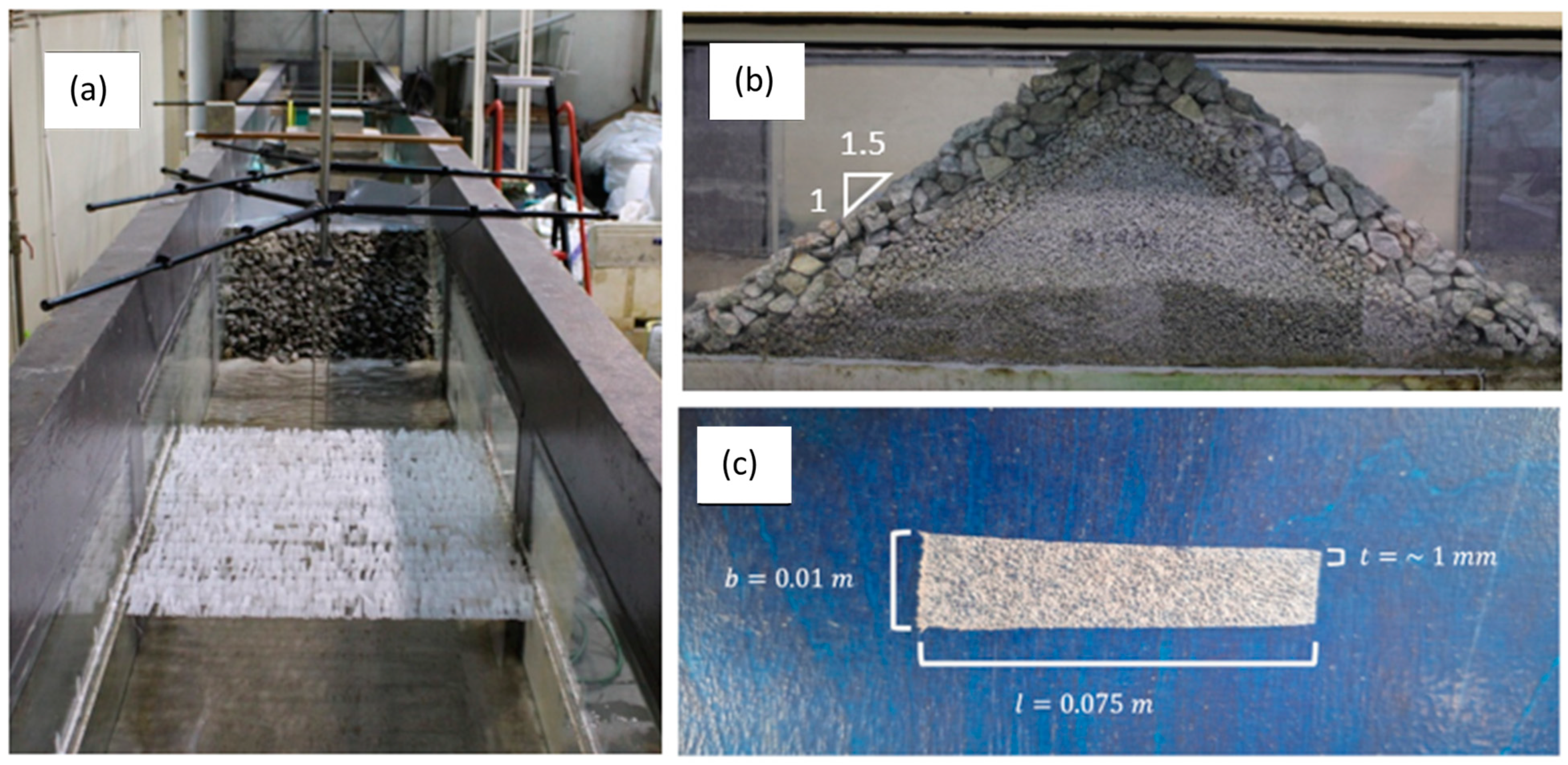
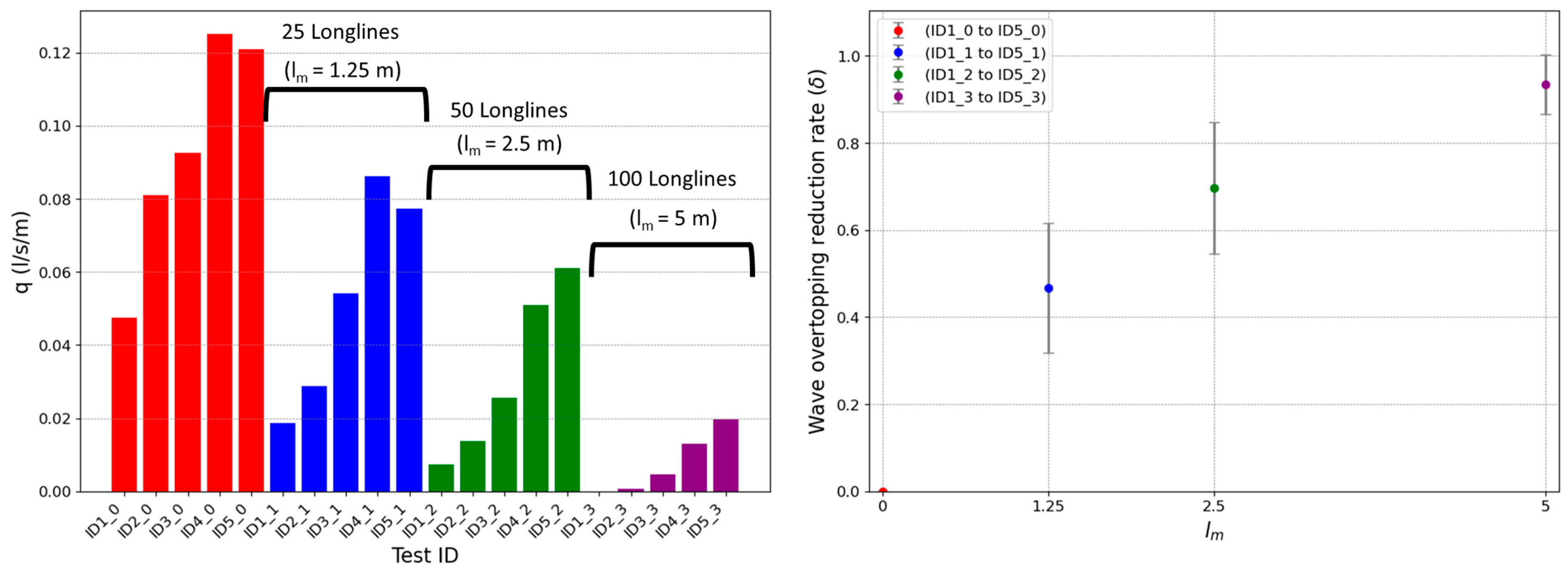

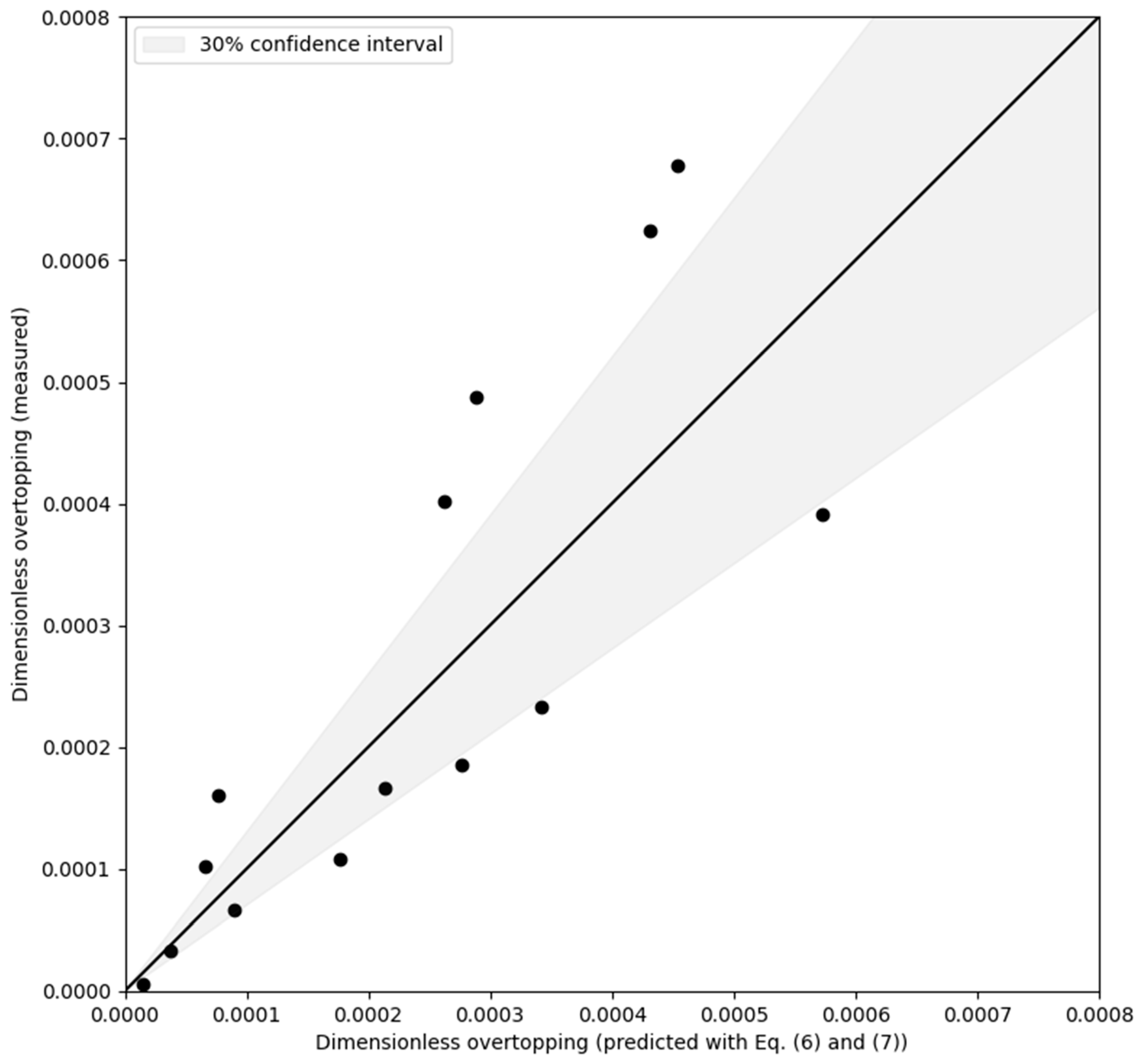
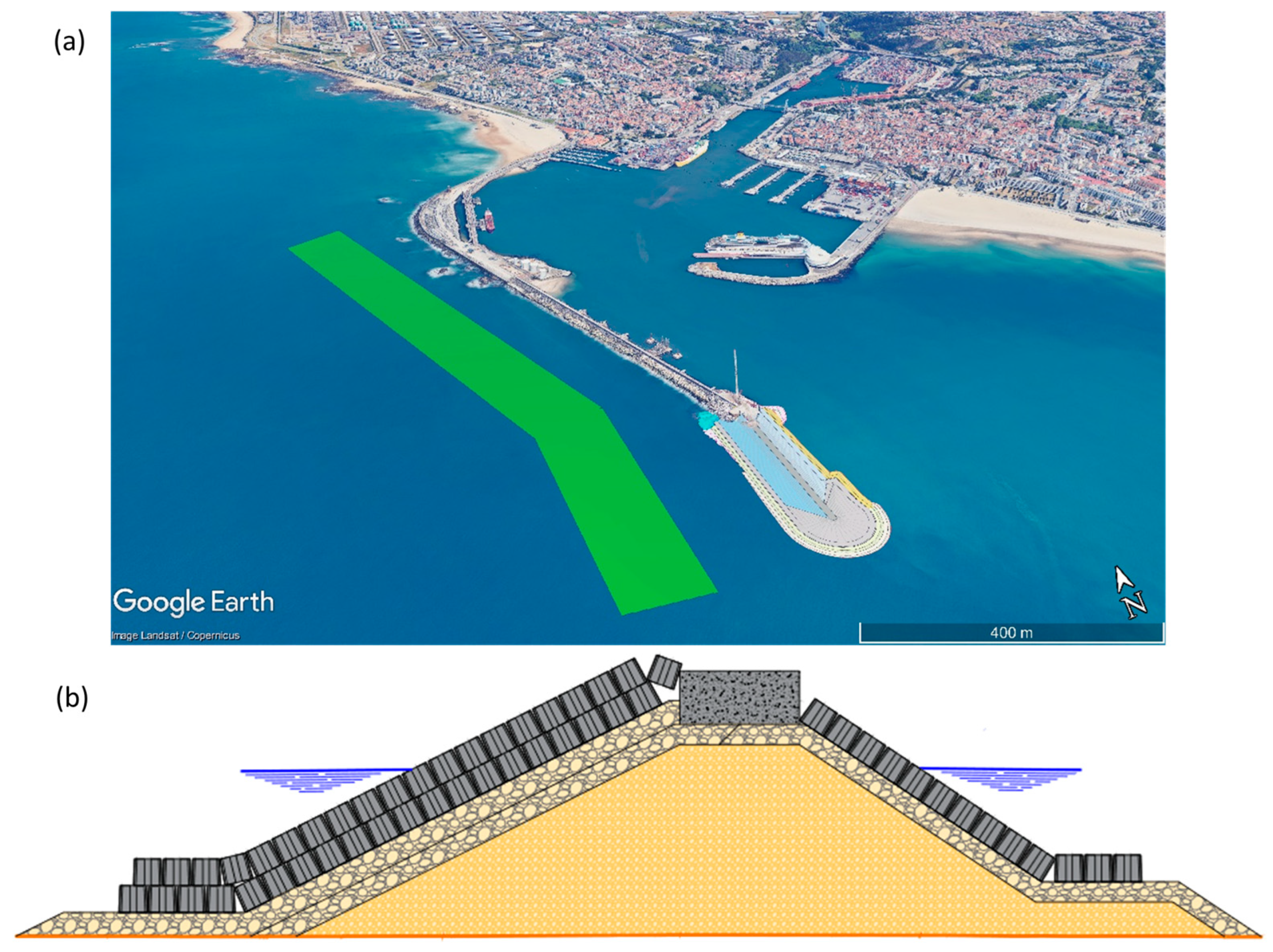
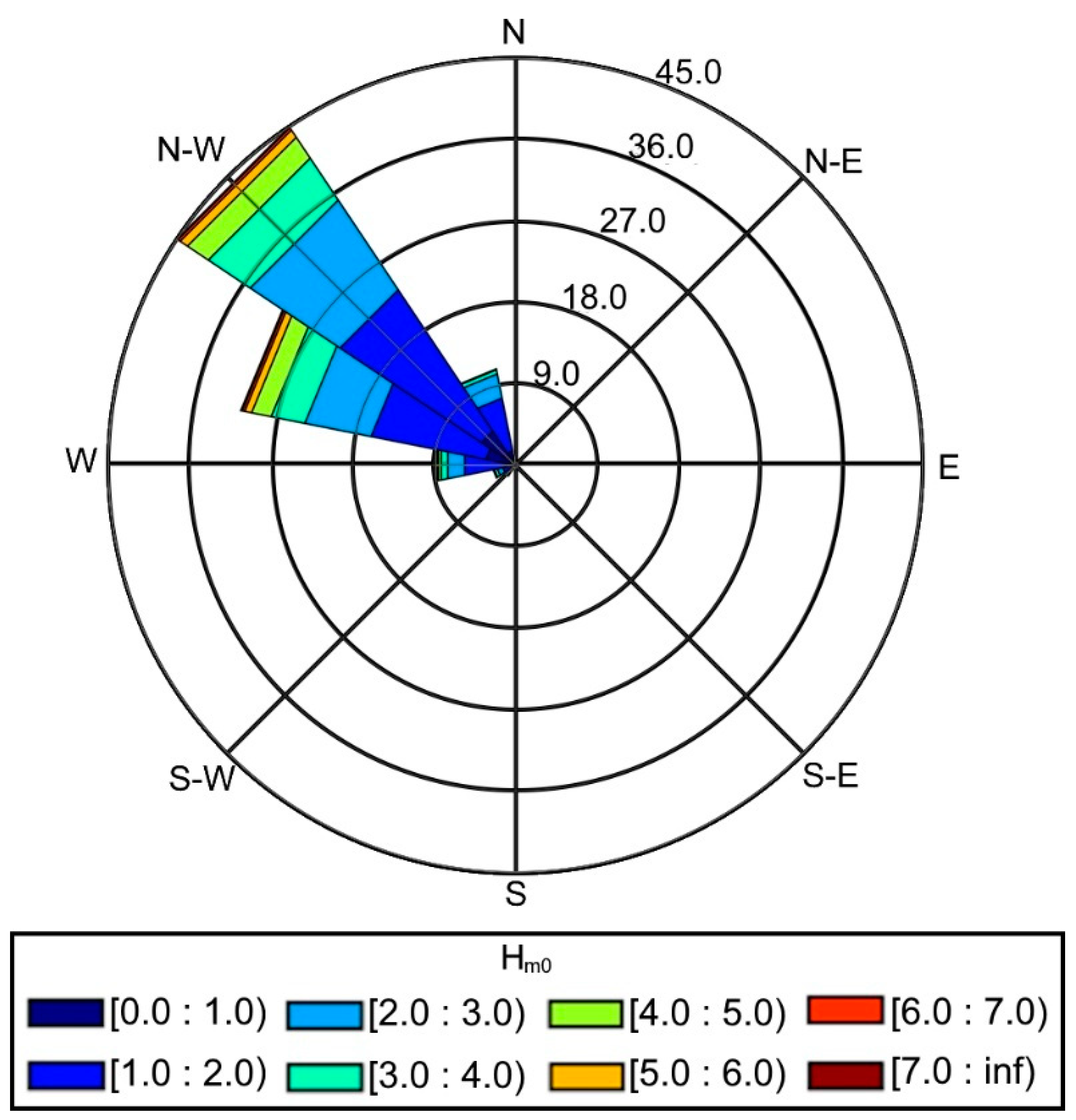

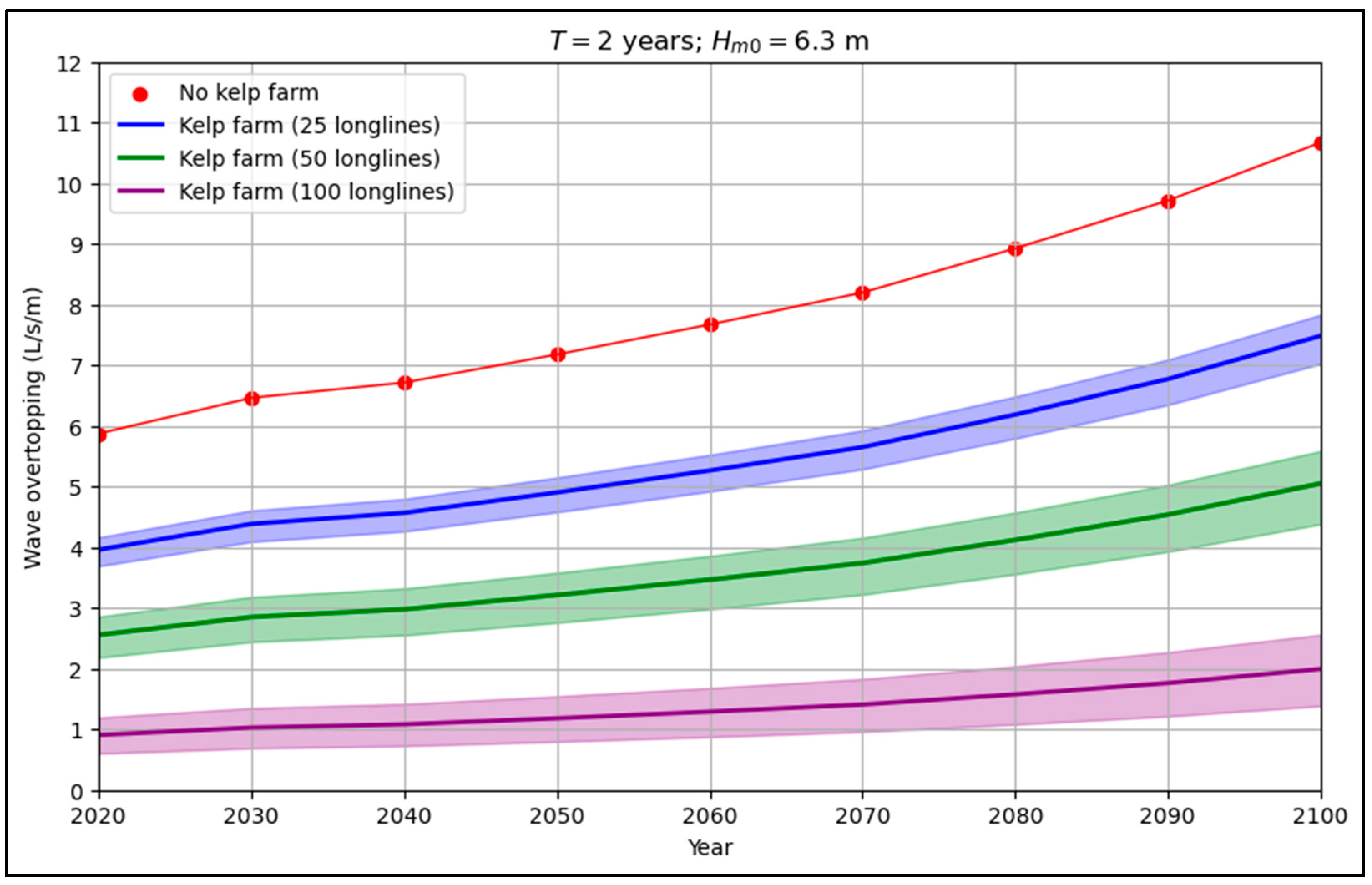
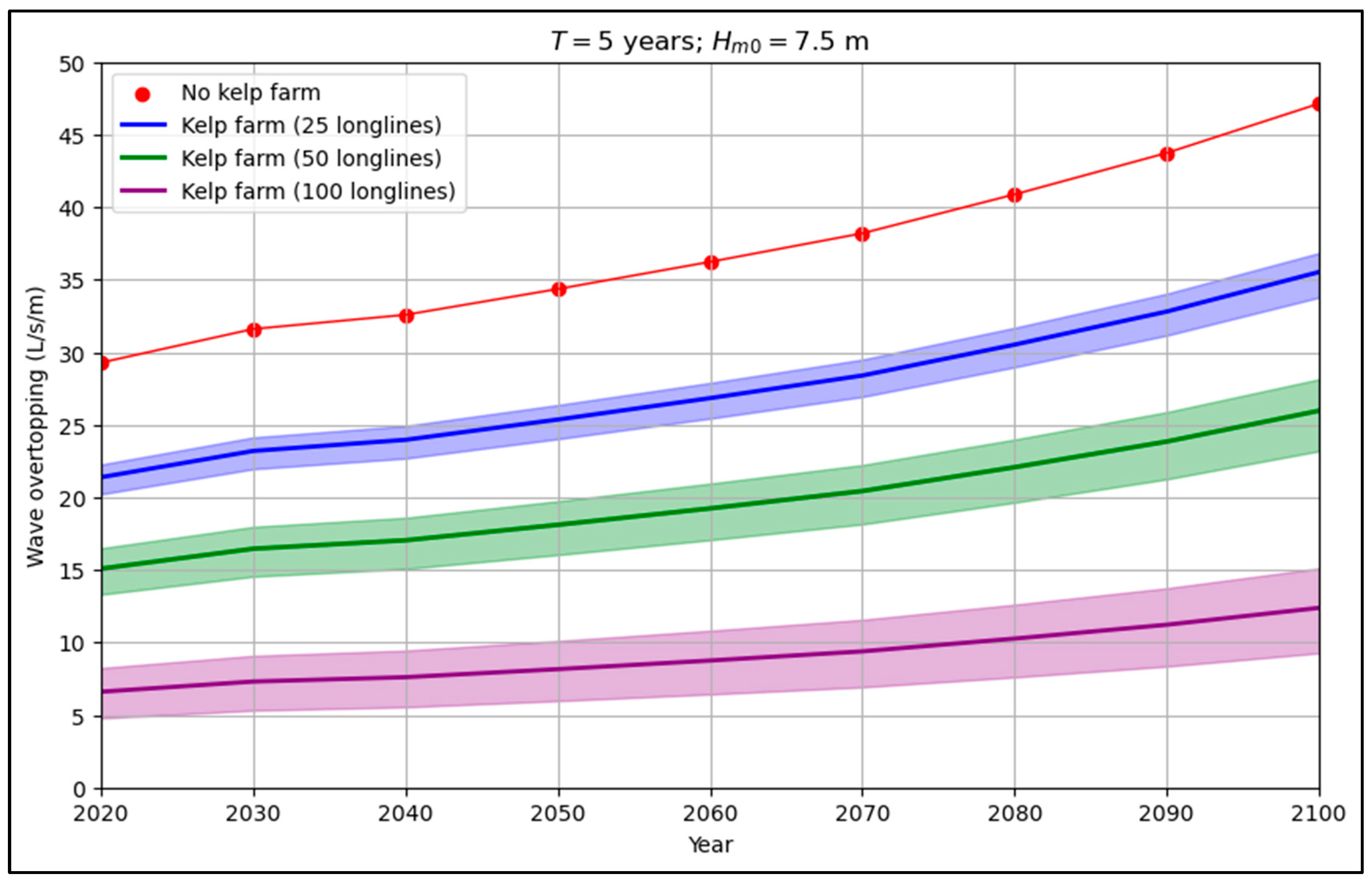
| (m) | λ (m) | s (-) | /h | ak | kh | ||||
|---|---|---|---|---|---|---|---|---|---|
| ID1_0 | 0.340 | 0.106 | 1.66 | 2.97 | 0.036 | 0.312 | 0.112 | 0.716 | 1.13 |
| ID2_0 | 0.114 | 1.66 | 2.97 | 0.038 | 0.335 | 0.120 | 0.716 | 1.05 | |
| ID3_0 | 0.121 | 1.66 | 2.97 | 0.041 | 0.356 | 0.127 | 0.716 | 0.99 | |
| ID4_0 | 0.115 | 2.17 | 3.90 | 0.029 | 0.338 | 0.092 | 0.545 | 1.04 | |
| ID5_0 | 0.116 | 2.44 | 4.51 | 0.026 | 0.341 | 0.081 | 0.472 | 1.03 |
| Polyurethane Foam (1:40 Geometrical Scale) | L. hyperborea [24,25] | L. digitata [24,25,26] | |
|---|---|---|---|
| , mass density (kg/m3) | 20 | 1070–1086 | 1001.5–1067 |
| , width (m) | 0.400 | 0.014–0.403 | 0.010–0.372 |
| , thickness (m) | 0.040 | 0.00057–0.013 | 0.0006–0.010 |
| , length (m) | 3 | up to 4 | up to 2–4 |
| , Elastic modulus (MPa) | 3360 | 1.2–109.4 | 1.1–3074 |
| (-) | 55.5–83.3 | 55.5–83.3 | 55.5–83.3 |
| (-) | 0.59 | 1.11–100.98 | 0.027–75.85 |
| (-) | 0.57–0.85 | 0.57–0.85 | 0.57–0.85 |
| (-) | 6.9–9.4 | 213.2–26,292.9 | 7.6–28,683.1 |
| Condition | (m) | (s) | |||||
|---|---|---|---|---|---|---|---|
| ID1 | 0.106 | 1.66 | 0.112 | 0.716 | 0.60 | 0.84 | 1.00 |
| ID2 | 0.114 | 1.66 | 0.120 | 0.716 | 0.64 | 0.83 | 0.99 |
| ID3 | 0.121 | 1.66 | 0.127 | 0.716 | 0.42 | 0.72 | 0.95 |
| ID4 | 0.115 | 2.17 | 0.092 | 0.545 | 0.31 | 0.59 | 0.90 |
| ID5 | 0.116 | 2.44 | 0.081 | 0.472 | 0.36 | 0.49 | 0.84 |
| Year | 2020 | 2030 | 2040 | 2050 | 2060 | 2070 | 2080 | 2090 | 2100 |
|---|---|---|---|---|---|---|---|---|---|
| SLR (m) | +0.00 | +0.10 | +0.14 | +0.21 | +0.28 | +0.35 | +0.44 | +0.53 | +0.63 |
Disclaimer/Publisher’s Note: The statements, opinions and data contained in all publications are solely those of the individual author(s) and contributor(s) and not of MDPI and/or the editor(s). MDPI and/or the editor(s) disclaim responsibility for any injury to people or property resulting from any ideas, methods, instructions or products referred to in the content. |
© 2025 by the authors. Licensee MDPI, Basel, Switzerland. This article is an open access article distributed under the terms and conditions of the Creative Commons Attribution (CC BY) license (https://creativecommons.org/licenses/by/4.0/).
Share and Cite
Miranda, F.; Calheiros-Cabral, T.; Mendes, D.; Rosa-Santos, P.; Taveira-Pinto, F.; Fazeres-Ferradosa, T. Reducing Wave Overtopping on Rubble Mound Breakwaters Using Floating Kelp Farms. J. Mar. Sci. Eng. 2025, 13, 850. https://doi.org/10.3390/jmse13050850
Miranda F, Calheiros-Cabral T, Mendes D, Rosa-Santos P, Taveira-Pinto F, Fazeres-Ferradosa T. Reducing Wave Overtopping on Rubble Mound Breakwaters Using Floating Kelp Farms. Journal of Marine Science and Engineering. 2025; 13(5):850. https://doi.org/10.3390/jmse13050850
Chicago/Turabian StyleMiranda, Filipe, Tomás Calheiros-Cabral, Diogo Mendes, Paulo Rosa-Santos, Francisco Taveira-Pinto, and Tiago Fazeres-Ferradosa. 2025. "Reducing Wave Overtopping on Rubble Mound Breakwaters Using Floating Kelp Farms" Journal of Marine Science and Engineering 13, no. 5: 850. https://doi.org/10.3390/jmse13050850
APA StyleMiranda, F., Calheiros-Cabral, T., Mendes, D., Rosa-Santos, P., Taveira-Pinto, F., & Fazeres-Ferradosa, T. (2025). Reducing Wave Overtopping on Rubble Mound Breakwaters Using Floating Kelp Farms. Journal of Marine Science and Engineering, 13(5), 850. https://doi.org/10.3390/jmse13050850










